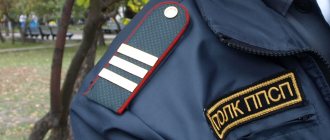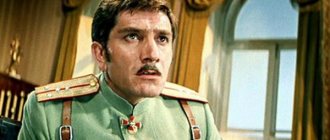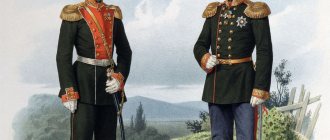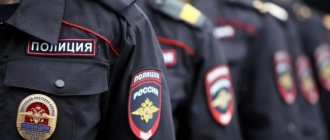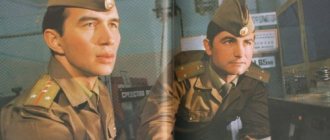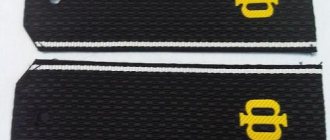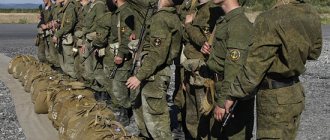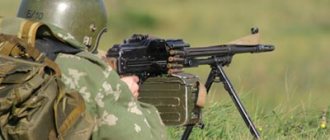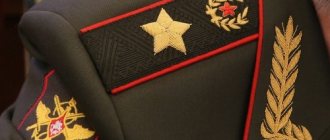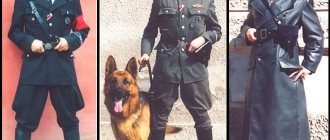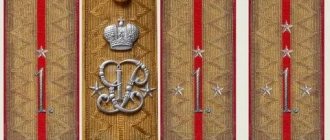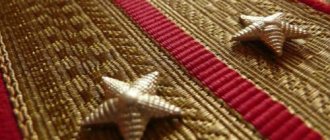Motivation
Bolshevism has evolved.
From nihilistic in relation to everything traditional, to everything national, to “everything that is beautiful and normal”1, his ideology turned into more and more tolerant.
It turned out that much more would have to be taken from the “damned past” into socialism than was imagined in 1917.
Because, from the point of view of most people, it is “beautiful and normal”!
Because in Russia - unlike, say, Austria and Hungary - they are accustomed to the fact that a military man must be in uniform.
And not only in Russia. “In general, when we entered Poland,” Yu.N., then commander of the battery, recalled about July 1944. Novikov, - the attitude of the Poles was quite interesting: they saw a new army, an army in uniform (and not the one that entered these areas between the Western Bug and Wiepsh at the end of September 1939 - Author). The officer units, they had some kind of feeling.” And they “kept asking us, asking us to sing the USSR Anthem. And when we sang this anthem, which contained the words that Rus' united all other parts, it was a majestic anthem, not the “Internationale”, this also played a certain role in the mood of the Poles”2.
Of course! After all, the shoulder straps, and “united forever by Great Rus',” and the dissolution in May 1943 of the “headquarters of the world revolution” - the Comintern - all this indicated that the USSR from the embryo of the “world republic of Soviets” was becoming a normal, national state. A state that defends the interests of its people - and not the “world proletariat”.
It is possible that it was the desire to present the USSR as a civilized country that prompted Stalin to make the decision in the spring of 1942 to introduce “generally recognized insignia - shoulder straps.” After all, the then commander of the artillery of the Red Army, N.N. Voronov testified that the shoulder straps were also intended to help interact with the allies3. And just in the spring of 1942, Stalin strenuously sought the opening of a “second front”...
Inheritance
The war also made us remember more often the glorious past of Russia and its army.
It encouraged, awakened the desire to “not put anyone to shame.”
According to the testimony of the Chief of Logistics of the Red Army A.V. Khrulev, when developing the first samples of shoulder straps, the quartermasters copied something from other armies, “made something themselves.”
But then Stalin ordered: “Show the shoulder straps that the tsar had.”4
As a result, the design type of the Soviet shoulder straps was repeated by the Russians.
Pentagonal or hexagonal. The soldiers' ones are made of colored cloth.
Sergeants have the same, with transverse or longitudinal stripes.
For officers, it is made of metal braid in two or three rows, with colored gaps between the rows and with stars.
For generals, it is made of wide braid with a zigzag pattern.
Field shoulder straps are made of khaki cloth.
Along with shoulder straps, a new form of clothing was introduced - the cut and details were reminiscent of the Russian ones of the 1910s.
Tunics with a stand-up (instead of a turn-down) collar, officer's tunics, ceremonial uniforms with a stand-up collar and braided buttonholes on the cuffs. Overcoat buttonholes are in the shape of a parallelogram (instead of diamond-shaped).
(True, they were allowed to wear the old uniform. Until the end of 1943, many wore shoulder straps on old tunics with a turn-down collar).
Editing the editorial of “Red Star” on January 6, 1943, Stalin emphasized: “It must be said that shoulder straps were not invented by us. We are the heirs of Russian military glory. We are not giving up on it..."6
What is the difference between an army general and a marshal?
Army General is a personal military rank of the Armed Forces of the Russian Federation, higher than the rank of Colonel General and lower than the rank of Marshal of the Russian Federation. ... To the military rank of an army general who is in reserve or retired, the words “reserve” or “retired” are added, respectively.
Interesting materials:
How to log into Rocketbank using your card number? How to restore the bonus card of my daughter and son? How to recover files from a damaged memory card? How to restore a flash card on your phone? How to restore a KB card using a phone number? How to restore an OK St. Petersburg card? How to restore the card ok? How to restore the Rosneft family team card? How to restore a card in Eldorado? How to restore chronology in Google maps?
Discipline
Another aspect of the problem was apparently revealed to Stalin by those front and army commanders who supported the idea of introducing shoulder straps. They are o7.
The decree of the Council of People's Commissars of December 15, 1917 explained the abolition of ranks and insignia by the fact that it was impossible to emphasize the superiority of one “citizen of the Russian Republic” over another.
But life quickly made me realize that there could be no equality in the army.
Because in the army there are not just bosses and subordinates. In the army, a subordinate, on the orders of his superior, must go to his death!
And he will not always be conscious enough for this. Many will have to suppress the instinct of self-preservation through the habit of following orders.
To develop such a habit, there must be iron discipline in the army.
This means that a subordinate cannot look at his boss as an equal! You can even disobey your equal - who is he, they say?
The boss’s appearance should also be a reminder of this natural inequality.
And already in 1919, the Red Army had to introduce insignia for positions. And in 1935 - according to military ranks.
But the insignia that existed by the 42nd - buttonholes - did not distinguish commanders as much as shoulder straps. Especially the field buttonholes, introduced in August 1941 in the active army - a protective color, with triangles, “cubes”, “ties” and general’s stars painted in the same color. They simply blended with the collar of the tunic into one faded tone.
The military uniform looked like civilian “clothes.”
How many sleepers does the major have?
2 sleepers
-
major
, battalion commissar, military engineer 2nd rank, quartermaster 2nd rank, military doctor 2nd rank, military officer 2nd rank.
Interesting materials:
What should an investment analyst know? What should a surveyor know? What should a Junior System Administrator know? What should a food service technologist know? What should be on a sales receipt? What should be in a commercial proposal? What should be in the practical part of the diploma? What should an expert opinion contain? What should be contained in an employee's personal file 2022? What must be paid after dismissal?
Stalin's pause
It is difficult to say who originated the idea of introducing shoulder straps - Stalin or those quartermasters who, from the beginning of 1942, designed, on his orders, external differences for the guards units. But the idea was born no later than the spring of 1942: already in May, Stalin introduced it to the Main Political Directorate of the Red Army. And at the end of September or beginning of October he spoke about the introduction of shoulder straps as if it was a done deal8.
However, the corresponding decree was prepared only on November 23.
And this is understandable. What's the point of introducing shoulder straps in an army that is retreating? She will only think angrily: “Is there nothing else to do?”
For shoulder straps to have the desired effect, they had to be associated with a turning point, with a cleansing thunderstorm. With a new, victorious army!
And the end of September - beginning of October 1942 was a time when no one knew whether Stalingrad would be able to be held...
When the troops who tried to liberate Leningrad during the Sinyavinsk operation died surrounded...
When the Germans, in Operation Michael, expanded the “Ramushevsky Corridor”, which led to their Demyan group, half-encircled in the Novgorod region...
And only on November 19, a cleansing thunderstorm struck - Operation Uranus. On the 23rd, the German army that stormed Stalingrad was surrounded.
This date - November 23, 1942 - was included in the draft decree of the Presidium of the Supreme Soviet of the USSR on the introduction of shoulder straps. Having imposed a resolution in favor, Stalin still waited a little longer - but by January 6, 1943, it became clear that the enemy would not break out of the ring...
Army reaction
The production of millions of pairs of shoulder straps was delayed. The transition to wearing them, which began on February 1, 1943, could not be completed either by February 15 or by March 15. Senior Lieutenant A.Z., who fought on the North Caucasus Front. Lebedintsev could not receive shoulder straps until June, and some pilots and tank crews entered the Battle of Kursk without them9...
What was the reaction of the Red Army? Those who were alienated from the past by the propaganda of the 20s and 30s experienced a shock. Here are just a few responses recorded on the Don Front.
“Even before I had an aversion to shoulder straps, but now the old thing is coming back, we’ll wear shoulder straps again” (junior military technician Rozhdestvensky).
“For 25 years under Soviet rule we fought against the old order, and now shoulder straps are being introduced again. Probably, they will soon introduce elders, as they were before, and then landowners and capitalists...” (senior sergeant Volkov).
“They want to create the old system and a fascist army again, because... epaulets are worn by fascists” (political instructor Balakirev)10.
From now on, for this “anti-Soviet agitation” they were registered in a special department...
There was also a reaction, which was recalled, for example, by N.I. Zhukov, then a guard lieutenant: “How strange it was for us with shoulder straps, we laughed at each other, that we looked like “white” officers”11.
Those who, despite many years of propaganda, felt what was “beautiful and normal” rejoiced!
“[...] We proudly wore a new uniform with gold shoulder straps and enjoyed universal respect,” recalled V.M. Ivanov, who studied at the Artillery Academy in 194312.
“[...] We, boys with the rank of cabin boy, were as proud of our shoulder straps as we were of decorations,” testified the writer Valentin Pikul, who graduated from the Navy cabin school in 194313.
And the scout of the 142nd Infantry Regiment A.A. Baranov, going on a sortie to enemy trenches on the night of July 3, 1943 on the Bryansk Front, protested against the order to remove his shoulder straps (as was expected of those going behind enemy lines):
“Why take off your shoulder straps? If you have to die, then die as an officer”14!
Officers
The last quote is to die as an officer! — is extremely remarkable. After all, Baranov was only a senior sergeant!
And by July 1943, officers in the USSR were also formally called “commanders and chiefs” (more precisely, middle and senior command and control personnel). The word “officer” appeared only in the titles of the positions “liaison officer” and “general staff officer.” True, in the order of the People's Commissar of Defense dated May 1, 1942, Stalin called the Soviet command cadres “officers” - but this had no consequences.
Propaganda of the 20s and 30s tirelessly insisted: officers belong to bourgeois armies. These are the servants of landowners and capitalists, executioners of workers and peasants...
But in the USSR, shoulder straps were historically associated with officer ranks...
It was not in vain that in March 1943, when he saw a man in uniform in Syzran - pilot O.V. Lazarev, - several military men who were still wearing buttonholes, “all as one, turned their heads” in his direction and saluted15. In uniform means boss! But Lazarev was an ordinary Red Army soldier...
And - a rare case! — the authorities began to indulge mass consciousness.
Without making changes to the regulations yet, after January 6, 1943, she gave the go-ahead to call middle and senior commanders also officers.
Just look at the article in “Red Star”, the central organ of the People’s Commissariat of Defense dated January 31, 1943. The familiar expression “commanders and soldiers” is adjacent to the new one – “officers and soldiers.” Mention is made of “our officer corps”, “the honor of the combat uniform of a Soviet officer”16...
It is not surprising that Sergeant Baranov wanted to feel like an officer. It's an honor to be one!
It is not surprising that A.A., who graduated from the accelerated infantry courses for mid-level commanders of the Western Front in Tushino, Moscow Region, in March 1943. Cherkashin later believed that their graduation “became the first officer graduation in the Soviet Army”: “They announced to us that we would go to the graduation course in Moscow along Red Square in the first parade of the Soviet officer corps.” (And they passed - “with gold shoulder straps on their shoulders, holding carbines “on hand”, in “eight by eight boxes”...)17
And from July 24, 1943, middle and senior commanders and superiors - from junior lieutenant to colonel inclusive - began to be formally called officers.
The decree of the Presidium of the Supreme Soviet of the USSR issued that day divided the military personnel not into privates, junior command and command and command and command personnel (as before), but into privates, sergeants, officers and generals.
Shoulder straps and insignia in Russia
Shoulder straps have a long history in the Russian army. They were first introduced by Peter the Great back in 1696, but in those days, shoulder straps served only as a strap that kept the gun belt or cartridge pouch from slipping off the shoulder. The shoulder strap was only an attribute of the uniform of the lower ranks: the officers were not armed with guns, and therefore they did not need shoulder straps.
Epaulets began to be used as insignia of rank with the accession of Alexander I to the throne. However, they did not denote rank, but membership in a particular regiment. The shoulder straps depicted a number indicating the number of the regiment in the Russian army, and the color of the shoulder strap indicated the number of the regiment in the division: red indicated the first regiment, blue the second, white the third, and dark green the fourth.
Since 1874, in accordance with the order of the military department No. 137 of 04.05. 1874, the shoulder straps of the first and second regiments of the division became red, and the color of the buttonholes and cap bands became blue. The shoulder straps of the third and fourth regiments became blue, but the third regiment had white buttonholes and bands, and the fourth regiment had green ones. Army (not guards) grenadiers had yellow shoulder straps. The shoulder straps of the Akhtyrsky and Mitavsky Hussars and the Finnish, Primorsky, Arkhangelsk, Astrakhan and Kinburn Dragoon Regiments were also yellow. With the advent of rifle regiments, they were assigned crimson shoulder straps.
Private, Non-Commissioned Officer, Junior Non-Commissioned Officer, Senior Non-Commissioned Officer
To distinguish a soldier from an officer, officer's shoulder straps were first trimmed with galloon, and since 1807, officers' shoulder straps were replaced with epaulettes. Since 1827, officer and general ranks began to be designated by the number of stars on their epaulettes: for warrant officers - 1, second lieutenant, major and major general - 2; lieutenant, lieutenant colonel and lieutenant general - 3; staff captain - 4; Captains, colonels and full generals did not have stars on their epaulettes. One star was retained for retired brigadiers and retired second majors - these ranks no longer existed by 1827, but retirees with the right to wear a uniform who retired in these ranks were preserved. Since April 8, 1843, insignia also appeared on the shoulder straps of lower ranks: one badge went to the corporal, two to the junior non-commissioned officer, and three to the senior non-commissioned officer. The sergeant major received a 2.5-centimeter-thick transverse stripe on his shoulder strap, and the ensign received exactly the same one, but located longitudinally.
In 1854, shoulder straps were also introduced for officers, leaving epaulettes only on ceremonial uniforms, and until the revolution there were almost no changes in shoulder straps, except that in 1884 the rank of major was abolished, and in 1907 the rank of ordinary ensign was introduced . Officials of some civil departments - engineers, railway workers, police - also had shoulder straps.
However, after the October Revolution, shoulder straps were abolished along with military and civilian ranks. The first insignia in the Red Army appeared on January 16, 1919. They were triangles, cubes and diamonds sewn onto the sleeves.
Rank insignia of the Red Army 1919-22
In 1922, these triangles, cubes and diamonds were transferred to sleeve valves. At the same time, a certain color of the valve corresponded to one or another branch of the military.
Rank insignia of the Red Army 1922-24
But these valves did not last long in the Red Army - already in 1924, rhombuses, kubars and triangles moved to the buttonholes. In addition, in addition to these geometric figures, another one appeared - a sleeper, intended for those service categories that corresponded to pre-revolutionary staff officers.
In 1935, personal military ranks were introduced into the Red Army. Some of them corresponded to the pre-revolutionary ones - colonel, lieutenant colonel, captain. Some were taken from the ranks of the former Tsarist Navy - lieutenant and senior lieutenant. The ranks corresponding to generals remained from the previous service categories - brigade commander, division commander, corps commander, army commander of the 2nd and 1st ranks. The rank of major, abolished under Alexander III, was restored. The insignia, in comparison with the buttonholes of the 1924 model, has hardly changed in appearance - only the four-cube combination has disappeared. In addition, the title of Marshal of the Soviet Union was introduced, no longer designated by diamonds, but by one large star on the collar flap.
Rank insignia of the Red Army 1935
On August 5, 1937, the rank of junior lieutenant (one kubar) was introduced, and on September 1, 1939, the rank of lieutenant colonel. Moreover, the three sleepers now corresponded not to the colonel, but to the lieutenant colonel. The colonel received four sleepers.
On May 7, 1940, general ranks were introduced. The major general, as before the revolution, had two stars, but they were located not on the shoulder straps, but on the collar flaps. The lieutenant general had three stars. This is where the similarities with pre-revolutionary generals ended - instead of a full general, the lieutenant general was followed by the rank of colonel general, modeled on the German general oberst. The colonel general had four stars, and the army general who followed him, whose rank was borrowed from the French army, had five stars. The insignia remained in this form until January 6, 1943, when shoulder straps were introduced into the Red Army. On January 13, they began to enter the troops.
Rank insignia of the Red Army 1943
Soviet shoulder straps had much in common with pre-revolutionary ones, but there were also differences: officer shoulder straps of the Red Army (but not the Navy) in 1943 were pentagonal, not hexagonal; the colors of the gaps indicated the type of troops, not the regiment; the clearance was a single whole with the shoulder strap field; there were colored edgings according to the type of troops; the stars were metal, gold or silver, and varied in size for junior and senior officers; ranks were designated by a different number of stars than before 1917, and shoulder straps without stars were not restored.
Soviet officer shoulder straps were five millimeters wider than pre-revolutionary ones. No encryption was placed on them. Unlike pre-revolutionary times, the color of the shoulder strap now corresponded not to the regiment number, but to the branch of the army. The edging also mattered. Thus, rifle troops had a crimson background shoulder strap and black edging, cavalry had dark blue with black edging, aviation had blue shoulder straps with black edging, tank crews and artillerymen had black with red edging, but sappers and other technical troops had black but with black edging. edging. Border troops and the medical service had green shoulder straps with red trim, and the internal troops received cherry shoulder straps with blue trim.
On khaki-colored field shoulder straps, the type of troops was determined only by the edging. Its color was the same as the color of the shoulder strap on the everyday uniform. Soviet officer shoulder straps were five millimeters wider than pre-revolutionary ones. Encryptions were placed on them very rarely, mostly by cadets of military schools. A junior lieutenant, a major and a major general received one star each. Two each went to a lieutenant, a lieutenant colonel and a lieutenant general, three each went to a senior lieutenant, a colonel and a colonel general, and four went to the captain and general of the army. The shoulder straps of junior officers had one gap and from one to four silver-plated metal stars with a diameter of 13 mm, and the shoulder straps of senior officers had two gaps and from one to three stars with a diameter of 20 mm.
Badges for junior commanders were also restored. The corporal still had one stripe, the junior sergeant had two, the sergeant had three. The former wide sergeant major's stripe went to the senior sergeant, and the sergeant major received the so-called “hammer” for his shoulder straps.
According to the assigned military rank, belonging to the branch of the military (service), insignia (stars and gaps) and emblems were placed on the shoulder straps. For military lawyers and doctors, there were “medium” sprockets with a diameter of 18 mm. Initially, the stars of senior officers were attached not to the gaps, but to the field of braid next to them. Field shoulder straps had a field of khaki color (khaki cloth) with one or two gaps sewn to it. On three sides, the shoulder straps had piping according to the color of the branch of service. Clearances were installed - blue - for aviation, brown - for doctors, quartermasters and lawyers, red - for everyone else.
The field of an everyday officer's shoulder strap was made of golden silk or galloon. Silver braid was approved for everyday shoulder straps of engineering and command personnel, quartermaster, medical and veterinary services and lawyers. There was a rule according to which silver stars were worn on gilded shoulder straps, and vice versa, gilded stars were worn on silver shoulder straps, except for veterinarians - they wore silver stars on silver shoulder straps. The width of the shoulder straps is 6 cm, and for officers of the medical and veterinary services, military justice - 4 cm. It is known that such shoulder straps were called “oaks” in the army. The color of the piping depended on the type of military service and service - crimson in the infantry, blue in aviation, dark blue in cavalry, a gilded button with a star, with a hammer and sickle in the center, in the navy - a silver button with an anchor.
General's shoulder straps of the 1943 model, unlike soldiers' and officers', were hexagonal. They were gold, with silver stars. The exception was the shoulder straps of generals of the medical and veterinary services and justice. Narrow silver shoulder straps with gold stars were introduced for them. Navy officer shoulder straps, unlike army ones, were hexagonal. Otherwise, they were similar to the army ones, but the color of the shoulder straps was determined: for officers of the naval, naval engineering and coastal engineering services - black, for aviation and engineering - aviation service - blue, quartermasters - crimson, for everyone else, including number of justice – red. Emblems were not worn on the shoulder straps of command and ship personnel. The color of the field, stars and edging of the shoulder straps of generals and admirals, as well as their width, were also determined by the branch of the army and service; the field of shoulder straps of senior officers was sewn from a special braid. The buttons of the Red Army generals had the image of the coat of arms of the USSR, and the admirals and generals of the Navy had the emblem of the USSR superimposed on two crossed anchors. On November 7, 1944, the location of the stars on the shoulder straps of colonels and lieutenant colonels of the Red Army was changed. Until this moment, they were located on the sides of the gaps, but now they have moved to the gaps themselves. On October 9, 1946, the shape of the shoulder straps of officers of the Soviet Army was changed - they became hexagonal. In 1947, on the shoulder straps of officers transferred to the reserve and retired by order of the Minister of the Armed Forces of the USSR No. 4, a golden (for those who wore silver shoulder straps) or silver (for gold-plated shoulder straps) patch was introduced, which they are required to wear when they put on a military uniform (in 1949 this the patch was cancelled).
In the post-war period, minor changes occurred in the insignia. Thus, in 1955, everyday field double-sided shoulder straps were introduced for privates and sergeants. In 1956, field shoulder straps for officers with stars and khaki emblems and clearances according to the branch of service were introduced. In 1958, the narrow shoulder straps of the 1946 model for doctors, veterinarians and lawyers were abolished. At the same time, the edging for everyday shoulder straps of soldiers, sergeants and foremen was also canceled. Silver stars are introduced on gold shoulder straps, and gold stars on silver ones. The colors of the gaps are red (combined arms, airborne troops), crimson (engineer troops), black (tank troops, artillery, technical troops), blue (aviation), dark green (medics, veterinarians, lawyers); blue (the color of cavalry) was abolished due to the liquidation of this type of troops. For generals of the medical, veterinary services and justice, wide silver shoulder straps with gold stars were introduced, for others - gold shoulder straps with silver stars. In 1962, the “Project for the abolition of shoulder straps in the Soviet Army” appeared, which, fortunately, was not implemented. In 1963, blue lights were introduced for airborne officers. The 1943 model sergeant's shoulder straps with the sergeant's hammer are being abolished. Instead of this “hammer”, a wide longitudinal braid is introduced, like a pre-revolutionary ensign.
In 1969, gold stars were introduced on gold shoulder straps, and silver stars on silver ones. The colors of the gaps are red (ground forces), crimson (medics, veterinarians, lawyers, administrative services) and blue (aviation, airborne forces). Silver general's shoulder straps are being abolished. All general's shoulder straps became gold, with gold stars framed with edging according to the branch of service.
In 1972, ensign shoulder straps were introduced. Unlike the pre-revolutionary ensign, whose rank corresponded to the Soviet junior lieutenant, the Soviet ensign was equivalent in rank to the American warrant officer.
In 1973, the codes SA (Soviet Army), VV (Internal Troops), PV (Border Troops), GB (KGB Troops) were introduced on the shoulder straps of soldiers and sergeants, and K on the shoulder straps of cadets. It must be said that these letters appeared back in 1969, but initially, according to Article 164 of Order of the USSR Minister of Defense No. 191 of July 26, 1969, they were worn only on the ceremonial uniform. The letters were made of anodized aluminum, but since 1981, for economic reasons, metal letters were replaced by letters made of PVC film.
In 1974, new army general shoulder straps were introduced to replace the 1943 model shoulder straps. Instead of four stars, they had a marshal's star, above which was the emblem of motorized rifle troops. In 1980, all silver shoulder straps with silver stars were abolished. The colors of the gaps are red (combined arms) and blue (aviation, airborne forces).
Shoulder straps SA 1982
In 1981, shoulder straps of a senior warrant officer were introduced, and in 1986, for the first time in the history of Russian officer shoulder straps, shoulder straps without gaps were introduced, differing only in the size of the stars (field uniform - “Afghan”). Currently, shoulder straps remain insignia of the Russian army, as well as some categories of Russian civil officials.
source
